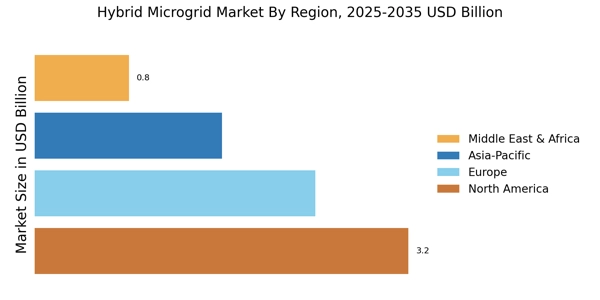Supportive Regulatory Frameworks
Supportive regulatory frameworks are essential for the growth of the Hybrid Microgrid Market. Governments worldwide are recognizing the importance of hybrid microgrids in achieving energy independence and sustainability goals. Policies that promote the deployment of hybrid microgrids, such as tax incentives, grants, and streamlined permitting processes, are becoming more prevalent. These regulatory measures not only encourage investment in hybrid microgrid projects but also facilitate the integration of renewable energy sources into existing grids. As regulatory environments evolve to support innovative energy solutions, the hybrid microgrid market is likely to benefit from increased adoption and implementation. Current trends suggest that favorable policies will continue to shape the landscape of the energy sector, further enhancing the role of hybrid microgrids.
Rising Demand for Energy Resilience
The Hybrid Microgrid Market is experiencing a notable increase in demand for energy resilience, particularly in regions prone to natural disasters and power outages. As communities seek to enhance their energy security, hybrid microgrids, which combine renewable energy sources with traditional power systems, offer a viable solution. This trend is underscored by a growing recognition of the vulnerabilities in existing energy infrastructure. According to recent data, the hybrid microgrid market is projected to grow at a compound annual growth rate of approximately 12% over the next five years. This growth is driven by the need for reliable energy systems that can operate independently during grid failures, thereby ensuring continuous power supply and reducing reliance on centralized energy sources.
Increased Investment in Renewable Energy
Investment in renewable energy technologies is a significant driver for the Hybrid Microgrid Market. As countries strive to meet their climate goals, there is a marked shift towards integrating renewable energy sources such as solar, wind, and biomass into microgrid systems. This transition is supported by various financial incentives and government policies aimed at promoting clean energy solutions. Recent statistics indicate that investments in renewable energy projects have surged, with a notable increase in funding for hybrid microgrid initiatives. This influx of capital not only facilitates the development of innovative technologies but also enhances the overall efficiency and sustainability of energy systems, making hybrid microgrids an attractive option for energy providers and consumers alike.
Technological Innovations in Energy Storage
Technological advancements in energy storage solutions are playing a crucial role in the Hybrid Microgrid Market. The development of more efficient and cost-effective battery technologies, such as lithium-ion and flow batteries, has significantly improved the viability of hybrid microgrids. These innovations enable better integration of intermittent renewable energy sources, allowing for smoother energy management and distribution. As energy storage systems become more accessible and affordable, the adoption of hybrid microgrids is likely to increase. Current estimates suggest that the energy storage market is expected to grow substantially, further bolstering the hybrid microgrid sector. This synergy between energy storage and hybrid microgrids enhances grid stability and reliability, making them a preferred choice for energy management.
Growing Urbanization and Electrification Needs
The rapid pace of urbanization is driving the demand for innovative energy solutions, thereby impacting the Hybrid Microgrid Market. As urban populations expand, the need for reliable and efficient energy systems becomes increasingly critical. Hybrid microgrids offer a flexible approach to meet the electrification needs of urban areas, particularly in developing regions where traditional grid infrastructure may be lacking. The integration of localized energy generation and consumption within hybrid microgrids can alleviate pressure on existing grids and reduce transmission losses. Recent projections indicate that urban areas will account for a significant portion of energy consumption in the coming years, highlighting the potential for hybrid microgrids to play a pivotal role in sustainable urban development.


















Leave a Comment